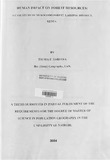| dc.description.abstract | The current study focuses on the two-way relationships between population and natural resources with specific emphasis on forest-cover change, particularly in east Laikipia. The study area, Mukogodo Forest, offers a field-laboratory type of conditions for studying the relationships between population pressure and natural resources. In addition it offers unique ecological conditions, as it is mainly inhabited by a pastoral community whose 'cattle-complex culture' has traditionally been portrayed to have serious implications on the forest resources. The study therefore examines the influence of human activities on Mukogodo Forest on which several sub-communities depend.
It will emphasize demand for wood-fuel including charcoal, timber supply for construction, medicinal value of the forest, honey harvesting as well as livestock rearing. Data for this research has been collected both from primary and secondary sources. Sources of primary data included questionnaire, observations as well as focused group discussions. The later includes both published and unpublished materials. The tests administered were based on the hypotheses that there were significant relations existing between aspects such as wood-fuel consumption, timber for, construction, extraction of traditional herbs, honey harvesting and animal rearing, and forest cover change on the other hand. The population targeted for this study comprised of all household heads located within 15 kilometers from the forest, the local forest officers and the chiefs of the area.
A total of 521 households w..se located within this area. A random sampling was done on the household heads whereby about ten (10) percent was picked for interviews. The analysis was done using Correlation and Regression techniques, Fisher's Test and a number of population and demographic' analysis techniques. Geographical information systems (G.I.S.) was used to analyze data on forest cover change, the data on forest cover change was got from aerial photographs, satellite imageries and topographical maps covering the area. From the correlation analysis results, it was established that the household size influences the volume of wood fuel and number of poles used for the construction of Manyattas and fencing.
Education levels of both sexes were found not to have any significant impact on the above. From the analysis of forest cover change, it was established that the forest cover has reduced over the years. This reduction is attributed to environmental changes that have seen rainfall decrease over the years wile temperatures increase over the same period (increase in aridity) as well as the nomadic way of life of the Masaai. In the light of research findings and conclusions made, a number of recommendations were drawn to the government, future researchers as well as the general public:- It was recommended that alternative sources of energy such as solar and kerosene should be provided to alleviate the overdependence on wood fuel which threatens the existence of the forests. Also, there is need to advice the Masaai pastoralists to adopt a rather settled kind of lifestyle.
This calls for t he government's commitment top rovide boreholes toe nable them to have water both for domestic and livestock use. For this to be practical, the pastoralists need to be encouraged to reduce the size of their heads of cattle, while other economic activities need to be initiated by government and non-governmental organizations. An attempt may be made to improve on both the forest management and conservation policies so as to ensure sustainability in the forest resources. There may be more campaigns on the conservation of resources.
This can be done through the media, seminars and barazas. Studies may be undertaken on all the three main components of population change, that is fertility, mortality and migration inorder to appreciate these changes and show how they affect forest cover change either individually of collectively in the study area. There is need to study the impact of forest cover change on the socio-economic life of the Masaai people in the study area. Researchers and scholars can find it interesting to make a detailed study of households income in relation to woodfuel consumption in this area | en |

